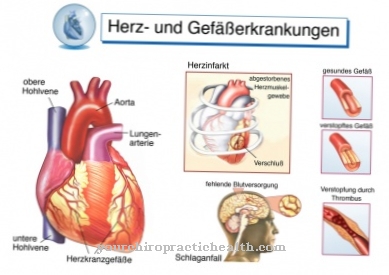A Hypomenorrhea is a menstrual disorder. The bleeding is very weak and usually lasts less than two days.
What is hypomenorrhea?

© photopixel - stock.adobe.com
As Hypomenorrhea denotes a missed, too weak or too rare menstruation. Menstruation is a monthly recurring uterine bleeding. If an egg is not fertilized during the cycle, the lining of the uterus is broken down and shed with the menstrual period. A woman's menstrual cycle typically lasts around 28 days, with a cycle being defined as the time from the first day of her menstrual period to the last day before her menstrual period.
A cycle length of 25 to 35 days is considered normal. The bleeding lasts an average of four days. During menstruation, a woman loses between 65ml and 200ml of fluid. This consists not only of blood, but also of other secretions and remnants of the mucous membrane. In hypomenorrhea, the bleeding usually lasts less than two days. The bleeding is very weak, so that the blood loss is often less than 25ml. One also speaks of Spotting. The cycle duration is unaffected by the disturbance.
causes
The causes of hypomenorrhea can be organic or hormonal. A common cause is atrophy of the uterine lining. Atrophy is a loss of tissue. This can be constitutional or caused by repeated scraping of the uterus, so-called curettages. Long-term use of progestins (luteal hormones) can also have a negative effect on the uterine lining.
Progestins are part of contraceptives such as the pill. As a result, if the lining of the uterus does not build up properly during the cycle, it cannot be shed. This results in less bleeding. Overweight women and women who suffer from anorexia can be particularly affected by hypomenorrhea. The reason for this is ovarian weakness.
The ovaries do not produce enough hormones due to malnutrition. This prevents the uterine lining from building up properly. This in turn leads to a reduced breakdown of the mucous membrane in the second half of the cycle. Stress is also a factor that affects menstrual bleeding. Mental stress, professional or private stress and even strong climatic changes such as on vacation have an influence on the monthly cycle and can cause hypomenorrhea.
Gynecological diseases such as ovarian cysts, endometriosis or cancer of the ovaries and the uterus should also be considered as possible causes of hypomenorrhea. The same applies to metabolic and hormonal disorders such as diabetes mellitus or thyroid dysfunction.
Symptoms, ailments & signs
Menstrual bleeding is very weak in hypomenorrhea. It rarely lasts more than two days, and in rare cases the bleeding only lasts a few hours. The amount of blood is rather small, mostly only spotting occurs. In contrast to hypermenorrhea, i.e. very heavy menstrual bleeding, hypomenorrhea usually does not cause any further symptoms.
A general feeling of illness, weakness or pain cannot be observed in the majority of cases. The hypomenorrhea is actually rather harmless, some women may even be grateful for the rather weak bleeding. Hypomenorrhea only becomes problematic when the person concerned wants to have children. The problem here is not the low menstrual period, but the weakly built up uterine lining on which the hypomenorrhea is based.
A prerequisite for pregnancy is that ovulation takes place and that enough uterine lining has built up so that the fertilized egg can implant itself. Hypomenorrhea can be an indicator that one or both of the conditions are not met.
Diagnosis & course of disease
The foundation of the diagnosis is a detailed anamnesis with precise documentation of the course of the cycle and the amount of bleeding. This is followed by a gynecological palpation of the ovaries and uterus. A womb is used to measure how thick the lining of the uterus is. A blood test should also be carried out to further clarify the cause.
Hormones such as estrogen, progestin, progesterone and testosterone are determined in the blood. Hormone diagnostics using the saliva is also possible. If more serious causes are suspected, such as cancer, imaging methods such as ultrasound or CT can be used. If a metabolic or thyroid disorder could be the cause of the hypomenorrhea, blood sugar and / or thyroid hormones must be tested.
If you want to have children, the cycle is examined more closely. It must be determined whether ovulation is still taking place at all or whether the hypomenorrhea is due to an insufficiently built up uterine lining. For this, the woman has to measure her basal temperature for a longer period of time every morning immediately after waking up. The temperature curve within the cycle can then be used to determine whether ovulation is taking place.
Complications
As a rule, hypomenorrhea does not cause any particular complications or symptoms. Because of the hypomenorrhea, the bleeding during the woman's period is very light and lasts only a very short period of time. This mainly leads to so-called spotting. However, there are no further complaints, so that the patient does not feel sick and does not suffer from pain.
In most cases, the hypomenorrhea is actually a desired effect, as the bleeding is reduced and there is no particular pain. However, hypomenorrhea can also be a sign that fertilization has not taken place and that the person concerned is not pregnant.
As a result, it is not uncommon for psychological complaints to occur when the couple's desire to have children cannot be fulfilled. The partner also suffers from mental illness. The hypomenorrhea is usually left untreated and will go away on its own. For this reason, there are no further complications. A change in living conditions often helps to influence the hypomenorrhea.
When should you go to the doctor?
If the menstrual period is repeatedly very weak, the gynecologist should be informed. Bleeding that lasts only a few hours to days is an indication of hypomenorrhea, which must be checked by a doctor in any case. Should a general feeling of illness or weakness develop, the gynecologist must be consulted on the same day. While the condition is relatively harmless, it can indicate infertility. Therefore, you should always see a doctor with hypomenorrhea, even if the weak bleeding may even be perceived as pleasant.
Women with atrophy of the uterine lining are particularly prone to developing hypomennorrhea. Long-term use of the pill can also cause menstrual cramps. Affected women should have a physical examination and talk to the doctor responsible about changing their medication. Patients suffering from hypomenorrhea in connection with a gynecological disease such as ovarian cysts or tumors should speak to their doctor. If you feel very unwell, you must go to a hospital.
Doctors & therapists in your area
Treatment & Therapy
Often times, hypomenorrhoeas normalize on their own. Especially if the triggers are psychological, the hypomenorrhea can go away on its own if the circumstances change, for example by reducing stress. In principle, therapeutic treatment is only necessary if the causes of the hypomenorrhea endanger the patient or if there is a desire to have children.
Therapy is usually carried out using hormone preparations. If the hypomenorrhea is caused by cancer or endometriosis, surgical procedures to treat the hypomenorrhea may be necessary.
You can find your medication here
➔ Medicines for menstrual crampsprevention
Since stress can negatively affect the cycle, hypomenorrhea can also be prevented by reducing stress. Relaxation methods such as autogenic training or gentle endurance sports can be helpful here. Weight normalization also has a positive effect on hypomenorrhea.
This applies to both underweight and overweight women. A balanced diet and the avoidance of stimulants such as alcohol or nicotine can also prevent hypomenorrhea. Regular preventive examinations at the gynecologist are useful as part of general prevention.
Aftercare
If the condition has normalized after hypomenorrhea, some follow-up advice is available for the affected women. Among other things, avoiding stress can help to improve living conditions and prevent the disease in the future. Therapy may also make sense, but is usually only an option for patients for whom the health risk is quite high or who wish to have a child.
Depending on the trigger for the menstrual cramps, the doctor may prescribe medication over the long term. These serve at the same time for aftercare and prevention. Relaxing techniques are also helpful, as are gentle exercise methods such as yoga. The normalization of body weight also plays a role after successful treatment.
This applies to both overweight and underweight women. In connection with giving up nicotine, alcohol and other stimulants, those affected strengthen their body awareness. With proven medicinal plants and household remedies, it is possible to carry out aftercare consistently.
In general, patients can forego strong medication with side effects if they choose the gentle method. In addition to these self-help measures, regular examinations by the gynecologist are important to ensure that there is no serious cause for the disorders.
You can do that yourself
Hypomenorrhea usually normalizes on its own. Various self-help measures and some resources from the household and nature promote recovery.
As with other menstrual cramps, the main thing that helps with hypomenorrhea is heat. A hot bath relaxes the muscles of the uterus and reduces cramps and pain. Movement - whether cycling, swimming or jogging - releases pain relieving endorphins and inhibits the production of prostaglandins, which cause pain and inflammation. Support bras help with chest pain.
A suitable remedy from nature is vitamin B6. Taken as a dietary supplement, the substance helps against irritability and depression. Magnesium also promises quick help. Naturopathy particularly recommends magnesium phosphate C12 or C6. Alternatively, the preparations Nux vomica and Pulsatilla can be used. Ginger and St. John's wort are also tried and tested remedies for menstrual cramps because of their soothing effects.
A change in diet also helps with hypomenorrhea. Soy products in particular should be on the menu as they reduce pain and prevent new complaints. If the symptoms do not subside despite all measures, it is best to speak to the gynecologist again.


.jpg)

.jpg)

.jpg)




















